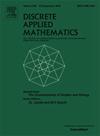极值四边形和星形嵌入的无符号拉普拉斯谱条件
IF 1
3区 数学
Q3 MATHEMATICS, APPLIED
引用次数: 0
摘要
无符号拉普拉斯谱半径已成为网络科学中一个重要的谱参数。本文通过研究具有禁止子图的图的无符号拉普拉斯谱半径(q指数),建立了谱图理论中新的极值结果。我们给出了经典nosal型定理的一个q谱类比,给出了在这类图中存在4环或大星K1,m−k的尖锐条件。主要定理表明,对于整数k≥0和有m条边且m≥max{7k+31,k2+8(k+1)}的图G,如果q(G)≥q(Sm,k+1+),则G必须包含一个4环或K1,m−k,除非G同构于极值图Sm,k+1+,该极值图Sm,k+1+是由星形K1,m−k−1加上k+1条独立边形成的。该结果完善了Wang和Guo(2024)之前关于星形嵌入的相关工作,并完成了Wang的4周包容邻接谱定理的q谱对应(Wang, 2022)。我们的分析揭示了无符号拉普拉斯特征值如何编码图结构的新见解,通过显式极值图构造和渐近分析证明了紧密的界限。本文章由计算机程序翻译,如有差异,请以英文原文为准。
Signless Laplacian spectral conditions for extremal quadrilateral and star embeddings
The signless Laplacian spectral radius has emerged as a crucial spectral parameter in network science. This paper establishes new extremal results in spectral graph theory by investigating the signless Laplacian spectral radius (-index) of graphs with forbidden subgraphs. We present a -spectral analog of classical Nosal-type theorems, providing sharp conditions that guarantee the existence of either a 4-cycle or a large star in such graphs. The main theorem states that for integers and graphs with edges where , if , then must contain a 4-cycle or , unless is isomorphic to the extremal graph formed by adding independent edges to the star . This result refines related previous work on star embeddings by Wang and Guo (2024), and completes the -spectral counterpart to Wang’s adjacency spectral theorem for 4-cycle containment (Wang, 2022). Our analysis reveals new insights into how signless Laplacian eigenvalues encode graph structure, with tight bounds demonstrated through explicit extremal graph constructions and asymptotic analysis.
求助全文
通过发布文献求助,成功后即可免费获取论文全文。
去求助
来源期刊

Discrete Applied Mathematics
数学-应用数学
CiteScore
2.30
自引率
9.10%
发文量
422
审稿时长
4.5 months
期刊介绍:
The aim of Discrete Applied Mathematics is to bring together research papers in different areas of algorithmic and applicable discrete mathematics as well as applications of combinatorial mathematics to informatics and various areas of science and technology. Contributions presented to the journal can be research papers, short notes, surveys, and possibly research problems. The "Communications" section will be devoted to the fastest possible publication of recent research results that are checked and recommended for publication by a member of the Editorial Board. The journal will also publish a limited number of book announcements as well as proceedings of conferences. These proceedings will be fully refereed and adhere to the normal standards of the journal.
Potential authors are advised to view the journal and the open calls-for-papers of special issues before submitting their manuscripts. Only high-quality, original work that is within the scope of the journal or the targeted special issue will be considered.
 求助内容:
求助内容: 应助结果提醒方式:
应助结果提醒方式:


